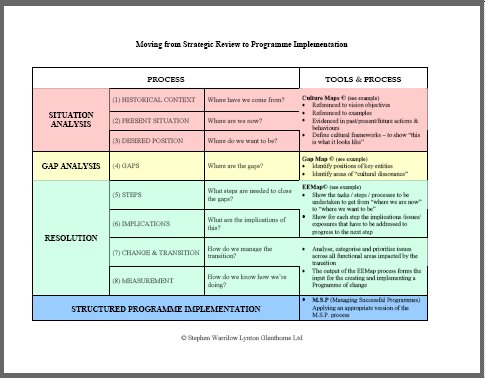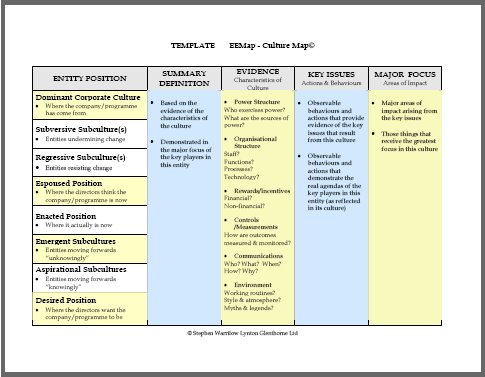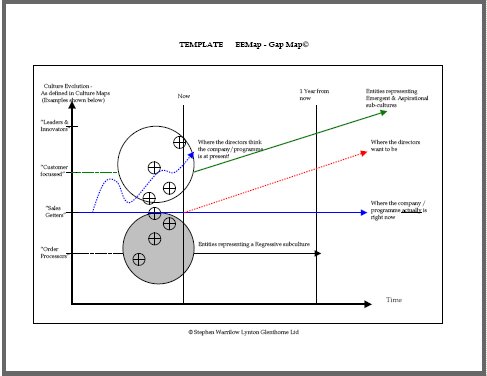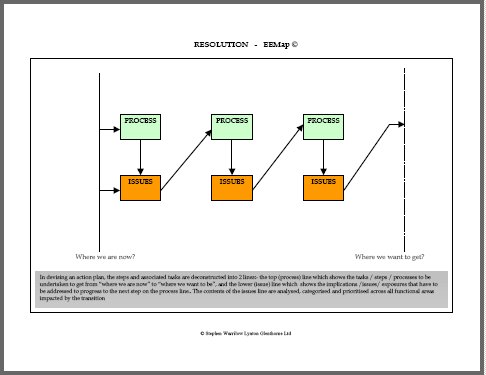|
Change management strategyHow to address the key strategic leadership issues by taking full account of the people who are most impacted by the change...
Change management strategy is very specifically about moving from the output of your strategic review to a successful programme implementation, whilst at the same time avoiding the 3 main causes of failure:
Bridging the gap between strategic vision and sucessful programme implementation
Take a look at this brief video of Ken Blanchard [One Minute Manager] on Change Strategy:
The strategic review process will address variations of the 3 standard questions: "Where have we come from - where are we now - and where do we want to be?" But to properly and thoroughly address the impact of the implementation of this change management strategy [and its full change implications] on those most affected, and also to begin addressing the WIFM question I use an additional set of processes that I have created and that unpack the cultural issues. I call this the EEMap(c) process [so called because it maps the route through the stages of Evolution from review to implementation and identifies and addresses all the Exposures enroute].
Here is an overview of the Pre-Programme Preparation process [or more correctly, set of processes].There are three phases to this process, in overview:
(1) Situation Analysis – that addresses the questions: Where have we come from? Where are we now? Where do we want to get?
Culture Map©
that defines a cultural framework for the company.
The cultural framework will also help to identify the significant subcultures. It will also help determine which of these are supportive and those which are not. This is created through sessions held with representative groups of all staff at all levels and in all entities that will be impacted by the proposed venture. Examples and previous templates are used to assist and speed up the process, which is also referenced, to vision, strategy and business objectives.
This phase is all about corporate cognition. The Culture Maps provide a common language and a structured framework to get an end result that is a shared understanding of “this is what we look like”. (2) Gap Analysis
The Gap Map will show the dominant corporate culture and highlight the gaps between this and the espoused position. The dominant culture is how the organisation actually is, and the espoused culture is the desired position i.e. "where we want to get to". Then, the gaps between all of the various subcultures are plotted. This is used to identify areas of “cultural dissonance” – a euphemism I use for friction and disconnects - and a very important aspect of change management strategy. The whole purpose at this stage is to create a simple visual representation of the various positions and to highlight the gaps between them. This is designed as a vehicle for staff at all levels to be able to articulate the reality of the gaps within their organisation. This is not a hard science but a simple tool for facilitating ths process in non-emotional and non-confrontational way.
(3) Resolution – taking the output of the Gap Map as the start point, the process now addresses the questions: What steps are needed to close the gaps? What are the implications of this?
But the significant feature of this process is that it also shows the implications, issues and exposures, which will have to be addressed and dealt with at each step before a successful transition will occur to the next step. The output of this process is used to address the questions: How are we going to manage the transition? How will we know how we’re doing? All implications, issues and exposures are assessed and prioritised across each of the functional areas that will be impacted by the change initiative. The change leaders can now evaluate the risks involved and determine appropriate courses of action. This analysis will provide the input to the next step whihc is the preparation and delivery of a programme plan and then eventually the project plans, and all against clear milestones. There are variations of how these Pre-Programme Preparation EEMap processes can be applied, with varying levels and permutations of involvement from directors, management and staff, and I would be very happy to discuss your change management strategy with you in more detail.
Further resourcesStrategic thinking and leadership - resources Strategic questions to ask yourself in planning your change initiative Strategic vision and programme implementation Return to: Strategies for managing change
|









